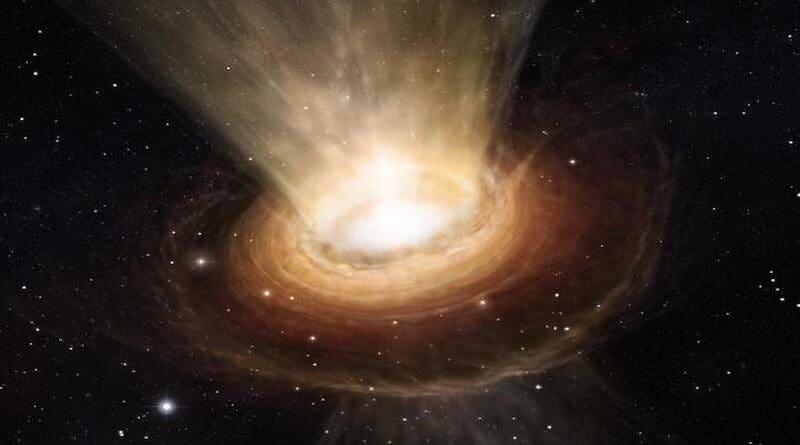JWST Captures The End Of Planet Formation
The James Webb Space Telescope (JWST) is helping scientists uncover how planets form by advancing understanding of their birthplaces and the circumstellar disks surrounding young stars, in a paper published in the Astronomical Journal, a team of scientists led by Naman Bajaj of the University of Arizona and including Dr. Uma Gorti at the SETI Institute, image for the first time, winds from an old planet-forming disk (still very young relative to the Sun) which is actively dispersing its gas content. The disk has been imaged before, winds from old disks haven’t. Knowing when the gas disperses is important as it constrains the time left for nascent planets to consume the gas from their surroundings.
At the heart of this discovery is the observation of TCha, a young star (relative to the Sun) enveloped by an eroding disk notable for its vast dust gap, approximately 30 astronomical units in radius. For the first time, astronomers have imaged the dispersing gas (aka winds) using the four lines of the noble gases neon (Ne) and argon (Ar), one of which is the first detection in a planet-forming disk. The images of [Ne II] show that the wind is coming from an extended region of the disk. The team, who are all members of a JWST program led by Ilaria Pascucci (U Arizona), is also interested in knowing how this process takes place so they can better understand the history and impact on our solar system.
“These winds could be driven either by high-energy stellar photons (the star’s light) or by the magnetic field that weaves the planet-forming disk,” said Naman.
Uma Gorti from the SETI Institute has been conducting research on disk dispersal for decades, and with her colleague predicted the strong Argon emission that JWST has now detected. She is “excited to finally be able to disentangle the physical conditions in the wind to understand how they launch.”
Planetary systems like our Solar System seem to contain more rocky objects than gas-rich ones. Around our Sun, these include the inner planets, the asteroid belt and the Kuiper belt. But scientists have known for a long time that planet-forming disks start with 100 times more mass in gas than in solids, which leads to a pressing question: when and how does most of the gas leave the disk/system?
During the very early stages of planetary system formation, planets coalesce in a spinning disk of gas and tiny dust around the young star. These particles clump together, building up into bigger and bigger chunks called planetesimals. Over time, these planetesimals collide and stick together, eventually forming planets. The type, size, and location of planets that form depend on the amount of material available and how long it remains in the disk. So, the outcome of planet formation depends on the disk’s evolution and dispersal.
The same group, in another paper led by Dr. Andrew Sellek of Leiden Observatory, performed simulations of the dispersal driven by stellar photons to differentiate between the two. They compare these simulations to the actual observations and find dispersal by high-energy stellar photons can explain the observations and hence cannot be excluded as a possibility. Andrew described how “the simultaneous measurement of all four lines by JWST proved crucial to pinning down the properties of the wind and helped us to demonstrate that significant amounts of gas are being dispersed.” To put it into context, the researchers calculate that the mass dispersing every year is equivalent to that of the moon! A companion paper, currently under review by the Astronomical Journal, will detail these results.
The [Ne II] line was first discovered towards several planet-forming disks in 2007 with the Spitzer Space Telescope and was soon identified as a tracer of winds by Project lead Prof. Pascucci at the University of Arizona; this transformed research efforts focused on understanding disk gas dispersal. The discovery of spatially resolved [Ne II] and the first detection of [Ar III] using the JWST could become the next step toward transforming our understanding of this process.
“We first used neon to study planet-forming discs more than a decade ago, testing our computational simulations against data from Spitzer, and new observations we obtained with the ESO VLT,” said Professor Richard Alexander from the University of Leicester School of Physics and Astronomy. We learned a lot, but those observations didn’t allow us to measure how much mass the discs were losing. The new JWST data are spectacular, and being able to resolve disc winds in images is something I never thought would be possible. With more observations like this still to come, JWST will enable us to understand young planetary systems as never before.”
In addition, the group has also discovered that the inner disk of T Cha is evolving on very short timescales of decades; they find that T Cha’s JWST spectrum differs from the earlier Spitzer spectrum. According to Chengyan Xie of the University of Arizona, the lead author of this in-progress work, this mismatch could be explained by a small, asymmetric inner disk that has lost part of its mass in only ~17 years. Along with the other studies, this also hints that the disk of T Cha is at the end of its evolution. Chengyan adds, “We might be able to witness the dispersal of all the dust mass in T Cha’s inner disk within our lifetime!”
The implications of these findings offer new insights into the complex interactions that lead to the dispersal of the gas and dust critical for planet formation. By understanding the mechanisms behind disk dispersal, scientists can better predict the timelines and environments conducive to the birth of planets. The team’s work demonstrates the power of JWST and sets a new path forward in exploring planet formation dynamics and the evolution of circumstellar disks.

